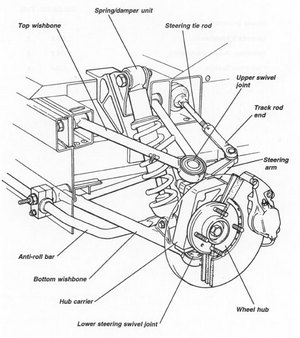The shock absorbers (or dampers) in a car’s suspension system smooth out the recoil action of the springs as they absorb shocks transmitted by bumps in the road. One or more faulty shock absorbers will adversely affect a car’s handling.
Most modern cars have telescopic shock absorbers, in which a piston operated by the movement of the car displaces oil at a controlled rate from one end of a cylinder to the other.
A telescopic shock absorber forming the main suspension leg and with a coil spring at the top, is called a MacPherson strut, and is used on many cars. Rear suspensions usually have a leaf or coil spring, with separate shock absorbers fitted between the axle or suspension arms and the bodywork.
Checking shock absorbers
Loosen the wheel nuts, jack up the car and support the chassis on axle stands so that the wheels hang free – never work under a car supported only by a jack. Remove the wheels.
Inspect each shock absorber for fluid leaks, which show as dark stains in the road grime that collects on its body and mounting points. Examine the body for deep dents, and the piston rod for signs of pitting or rusting. Any of theses faults call for a replacement unit.
The ends of the shock absorber are bolted through rubber bushes. Grip the upper and lower part of the unit and try to move it backwards and forwards; then twist it about its mounting bolt. If there is any movement replace the bushes.
The bounce test
Grip the bodywork above a wheel and bounce it vigorously a few times, then let go. The body should continue to bounce about twice more and then stop in its normal position. If it continues to bounce, the shock absorber at that point is weak.
Removing a shock absorber
With the car still on axle stands, place a jack under the suspension arm for a front shock absorber, or under the axle at the rear.
Locate the top mounting, which may be like the bottom one, or may be a threaded end of the piston called a pin mounting – it may protrude into the boot and you may have to remove some trim to get at it. For a pin mounting, count the number of threads above the nut; the same number must show when the shock absorber is replaced.
Note the positions of any washers and spacers while removing a shock absorber, and if you are fitting a new one use the new fixings supplied.
Replacing units for a MacPherson strut is better left to a garage, as special tools are needed.
Replacing bushes
An eye-type rubber bush may be in two halves with a steel sleeve through the middle. Pull out the old bush and lubricate the eye with a soap solution. Fit one half of the new bush with the sleeve inserted and push in the other half as far as possible. Place the eye in a vice and tighten it to squeeze the bush into place.
To replace a one-piece bush, take a socket large enough to take the bush and place it in a vice on one side of the eye. Place the new bush on the other side and squeeze with the vice to push the old bush into the socket as the new one is forced into the eye.




